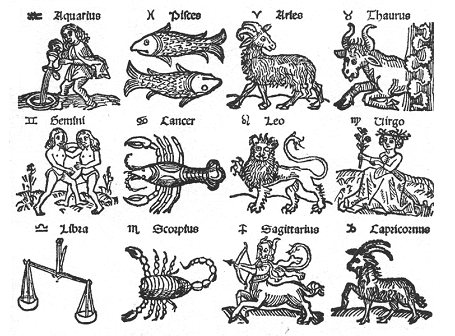

The zodiac is the belt or band of constellations through which the Sun, Moon, and planets appear to pass/transit across the sky. Early sky-watchers had noted these constellations and attached a particular significance to them. Astrologers understood the movement of the planets and the Sun through the zodiac as a means of explaining and predicting events on Earth, and also defining the character of an individual depending on which section or "sign" the sun was in at the time of birth. Later on this would develop into the system of the zodiac as we know it today.
 We know that the Sun is a fixed star. It doesn't move. But from our perspective on earth the Sun appears to pass across the sky, circling the earth once a year. As it makes it's way around the heavens each year it passes through the constellations, thus forming the zodiacal "belt" across the night sky. The Moon and the 9 Planets of the solar system also move within that belt. The path of the Sun is called the "ecliptic" because eclipses occur when the Moon's orbit crosses the Sun's path.
We know that the Sun is a fixed star. It doesn't move. But from our perspective on earth the Sun appears to pass across the sky, circling the earth once a year. As it makes it's way around the heavens each year it passes through the constellations, thus forming the zodiacal "belt" across the night sky. The Moon and the 9 Planets of the solar system also move within that belt. The path of the Sun is called the "ecliptic" because eclipses occur when the Moon's orbit crosses the Sun's path.
The zodiac is divided into 12 parts based on the constellations they originally represented, each one depicted by a symbolic image, and having associated characteristics. Each culture gave the constellations of the zodiac different names. The modern western zodiac was derived from the early Greeks.
These greek-named zodiacal constellations, in order around the sky, are: Aries, the Ram; Taurus, the Bull; Gemini, the Twins; Cancer, the Crab; Leo, the Lion; Virgo, the Virgin; Libra, the Scales; Scorpius, the Scorpion; Sagittarius, the Archer, Capricornus, the Sea Goat; Aquarius, the Water Carrier, and last but not least, Pisces, the Fish.
In modern astrology, two different zodiacs are popularly recognized. In Western Astrology a majority of astrologers use what is known as the Tropical Zodiac, (this is also the method focused upon in this astrological tutorial) and is based upon an age-old system that has not changed in it's symbolic meaning..
Due to the Precession of the Equinoxes, the twelve zodiacal signs in western astrology no longer correspond to the same part of the sky as their original constellations, meaning the link between sign and constellation has been broken. If you were to physically observe the constellation know as Aries today, it would no longer correspond to the same section of the sky where Aries the constellation was observed in ancient times. Nevertheless this ancient zodiac is still used today.
Alternatively a new astrological system was introduced, one which uses a more scientific approach to the astrological calculations, taking into account the precession of the equinoxes. This system uses what's known as the Sidereal Zodiac. This zodiac uses the same evenly divided ecliptic but approximately stays aligned to the positions of the observable constellations with the same name as the zodiacal signs. This system is central to Eastern astrology (Jyotish Astrology, Vedic Astrology, Indian Astrology, et cetera,).
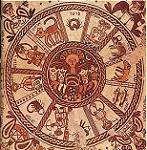 In ancient days the earth was believed to be flat, and the heavens above appeared as a giant dome that contained the earth beneath it. A new vision of the earth and sky emerged over time, this new perspective considered the heavens to be sphere-shaped, with the earth and it's very center. From the perspective of an observer on the surface of the earth, the sun appeared to travel across the edge of this sky bubble. Every year the sun appeared to make complete circle in the heavens around them. The path of the sun as it appears to circle around the earth is known as the Ecliptic
In ancient days the earth was believed to be flat, and the heavens above appeared as a giant dome that contained the earth beneath it. A new vision of the earth and sky emerged over time, this new perspective considered the heavens to be sphere-shaped, with the earth and it's very center. From the perspective of an observer on the surface of the earth, the sun appeared to travel across the edge of this sky bubble. Every year the sun appeared to make complete circle in the heavens around them. The path of the sun as it appears to circle around the earth is known as the Ecliptic
see also: The origins and History of Astrology and the Zodiac
The narrow band of the sun's path is called the Zodiac.
The zodiac is recognized as the first known celestial coordinate system.
The term Zodiac comes from the greek word Zodiakos which means "circle of animals." Early stargazers noticed specific stars that were grouped together and formed images of animals. These star-groupings became known as constellations and were each considered important and given special names and meanings. This "belt" of constellations is the Zodiac as we still know it today. Within the zodiac belt are the planets and the stars, which appear to move along the same path of sky as the sun does as it circles the entire earth.
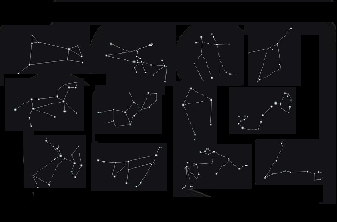
The zodiac is divided into the twelve distinct sections, each section representing one of the constellations. The 12 astrological signs were born. Since we know that the sun is not physically circling the earth, as once thought, it still "appears" that way from our perspective on the earths' surface. The zodiac belt can thus be considered an "imaginary" path that the celestial bodies travel through as they make there journey around the earth.
The 12 constellations or "sections" that divide the zodiac contain actual stars that are still observable today. If you could simultaneously stand at different parts of the earth you would see all twelve of these constellations at one time. But of course being in only one part of the world at one time only allows us to see some of the constellations at any given time, depending on the month of the year.
The 12 constellations each have a story that has been handed down through ancient myths long before they were actually categorized by astronomers such as Ptolemy who had first recorded them. The associated names, characteristics and traits still remain a large part of the star signs known in astrology today.
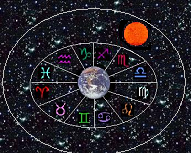 Even though we know the sun is fixed in it's place, from an earthly observers perspective it appears to move.
Let us suppose that you stood outside and gazed at the sun (not recommended) for an entire year, mesmerized, as it appeared to magically "move around the sky". You would notice that the sun travels a narrow path around the entire earth. This path is called the Ecliptic. (see image) One year in our time marks the completion of it's journey, and then of course it follows the same path around our earth again, marking another year.
Even though we know the sun is fixed in it's place, from an earthly observers perspective it appears to move.
Let us suppose that you stood outside and gazed at the sun (not recommended) for an entire year, mesmerized, as it appeared to magically "move around the sky". You would notice that the sun travels a narrow path around the entire earth. This path is called the Ecliptic. (see image) One year in our time marks the completion of it's journey, and then of course it follows the same path around our earth again, marking another year.
Remember that the early astrologers (and astronomers today) divided the sky-path of the sun into 12 separate sections or "zones" which were each marked according the star-groupings contained within it known as the constellations, or "star signs". The entire "sky dome" is considered to be 360 degrees, with each section or "sign" of the zodiac being about 30 degrees each. As the sun travels through the sky along it's ecliptic path it passes through each of the twelve zodiac signs/constellations along the way, spending around 30 days in each sign.
In ancient Babylonian times the science of astrology was developed and the constellations were named for the "actual physical constellations" that were being observed. It was around this time that the early astronomers first noticed that the sun journeyed through the same constellations each year. During the spring the path of the Sun crossed over the constellation of Aries, and in the fall it crossed over the constellation of Libra.
 The point or beginning of an "astrological year" is called the vernal equinox. This is where the sun's path (ecliptic) crosses the celestial equator.
The point or beginning of an "astrological year" is called the vernal equinox. This is where the sun's path (ecliptic) crosses the celestial equator.
The celestial equator is the line that divides the sky into a northern and southern half. At the point of the vernal equinox day and night are of equal length in time. There are 2 equinoxes each year, Vernal equinox begins in the spring and autumnal equinox begins in autumn. The vernal equinox actually begins the astrological sign of Aries the ram and the first half of the zodiac. (aries, taurus, gemini, cancer, leo, virgo). The autumnal equinox begins with the seventh sign of Libra and the second half of the zodiac (libra, scorpio, sagittarius, capricorn, aquarius, pisces.)
In the early beginnings of astrology the vernal equinox always signaled the beginning of the Sun's entrance into the sign of Aries, and also into the actual physical constellation of Aries. Both the star grouping known as the constellation of aries, and the astrological sign known as Aries the Ram were both considered to be identical.
Since those time astrology and astronomy began to diverge over the years and the 12 signs of the zodiac no longer correspond to the same physical constellations in the sky. So in modern times when as astronomer talks about "Gemini" they are referring to the actual group of stars in the sky that make up the actual constellation of Gemini. In astrology, Gemini is associated with the 30 degree segment of the zodiac, or the third astrological sign, which is has a symbolic meaning and is associated with a specific set of characteristics.
 Around the 2nd Century B.C.E the Greek astronomer Hipparchus discovered an unusual phenomenon that is known today as the precession of the equinoxes. The earth seems to slowly "shift" slightly in it's position as it spins through the solar system. This is referred to as the earth's "wobble". Instead of remaining upright in position, the top and bottom poles of the earth lean from side to side as it revolves on its axis. After many many years, this leaning of the earth changed the placement of the placement of the celestial equator. This is because the celestial equator is on the same line as the earths equator, the only difference is that it is projected out into the heavens. As the position of the earth shifts the line of the celestial equator shifts.
Around the 2nd Century B.C.E the Greek astronomer Hipparchus discovered an unusual phenomenon that is known today as the precession of the equinoxes. The earth seems to slowly "shift" slightly in it's position as it spins through the solar system. This is referred to as the earth's "wobble". Instead of remaining upright in position, the top and bottom poles of the earth lean from side to side as it revolves on its axis. After many many years, this leaning of the earth changed the placement of the placement of the celestial equator. This is because the celestial equator is on the same line as the earths equator, the only difference is that it is projected out into the heavens. As the position of the earth shifts the line of the celestial equator shifts.
Now remember that the vernal equinox is the "point" or beginning of where the path of the Sun crosses the celestial equator. Over time the vernal equinox takes place in an entirely different constellation. So the precession of the equinoxes" is the slow motion of the earth's tilt, because during the span of many years the equinoxes slowly travel through "all" of the constellations of the zodiac, but in a backward order. Precession is not to be confused with "procession" which would be a forward order, not backwards as with the precession of the equinoxes as explained here.
When the ancient Babylonians calculated the zodiac, the vernal equinox actually took place in the constellation of Aries. Around the time of the birth of Christ (which was the beginning of A.D.), the earth had shifted enough so that the vernal equinox then took place in the constellation of Pisces instead. The next shift will bring cause the vernal equinox to take place in the constellation of Aquarius. (moving "backwards" through the zodiac aquarius is before pisces). Yes, just the song, "this is the dawning of the age of aquarius".
The equinoxes move through the zodiac at a rate of approximately one degree every 7 and a half years. But about every 2,150 years the equinoxes move through "one" particular sign of the zodiac. So in a time span of about 25,820 years the equinoxes move through the entire twelve signs of the zodiac. This 26,000 (approximately) time frame is considered a Great Year. Each of the 2,100-year transits through one individual sign is called a Great Month, A great month is also called an "Age".
 For the past 2,000 years (give or take a few years) we have been in the Age of Pisces. Remember that we entered this age around the time of the birth of Christ. Perhaps this is why the piscean age, and the birth of Christ that marks the beginning of this "new age", is often symbolized by the fish. (e.g. the popular Jesus fish which represents Christianity) and thus Pisces which is represented by fish. As Christianity emerged Astrology started to became associated with mystery and the occult, causing it's use to decline in the west and practitioners to be criticized, ridiculed, sometimes even punished.
For the past 2,000 years (give or take a few years) we have been in the Age of Pisces. Remember that we entered this age around the time of the birth of Christ. Perhaps this is why the piscean age, and the birth of Christ that marks the beginning of this "new age", is often symbolized by the fish. (e.g. the popular Jesus fish which represents Christianity) and thus Pisces which is represented by fish. As Christianity emerged Astrology started to became associated with mystery and the occult, causing it's use to decline in the west and practitioners to be criticized, ridiculed, sometimes even punished.
Prior to the Piscean age would have been the age of Aries the Ram, before that would have been the age of Taurus the bull, and so forth "backwards" through the zodiac following the precession of the equinoxes.
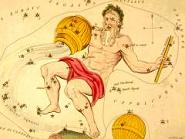 So this means that currently we are about the equinoxes are about to move through the sign of aquarius, the next "Great Month", also known as the Age of Aquarius. Some astrologers calculate that we have already entered this new age. If you take into account the qualities and characteristics that are associated with the astrological sign of aquarius, then you will see that this is most likely the case. In these changing times we are seeing the "aquarian" qualities being reflected on our planet and in our society. Each age is characterized by the astrological sign of that era and would take on those characteristics, both negative and positive.
So this means that currently we are about the equinoxes are about to move through the sign of aquarius, the next "Great Month", also known as the Age of Aquarius. Some astrologers calculate that we have already entered this new age. If you take into account the qualities and characteristics that are associated with the astrological sign of aquarius, then you will see that this is most likely the case. In these changing times we are seeing the "aquarian" qualities being reflected on our planet and in our society. Each age is characterized by the astrological sign of that era and would take on those characteristics, both negative and positive.
Aquarius is the age of spirituality and enlightenment, humanitarian efforts and ideals, advanced technological inventions, expanding scientific research and discoveries, eccentric and rebellious attitudes, and the uncanny and mysterious world of the paranormal.
Swiss Psychologist Carl Jung predicted that the new age of aquarius would begin around the 1990's. Since science estimates that are earth is around 4 billion years old, in it's long existence it has passed through about 177,00 great years or ages, and it will continue to do so, continually cycling through the reverse order of the zodiac signs, and always taking on the attributes of the associated sign. The early neanderthal man lived about nine great years ago, and the earliest creatures to walk upright before that existed around 115 Great Years ago (approximately 3 million years ago).
More About The Age of Aquarius
There are two systems of astrology that are in use today. Tropical astrology and Sidereal astrology. Tropical astrology is considered the traditional style and is mostly used in the western part of the world. This system uses the tropical zodiac. This is the method that is mostly explained in this astrological tutorial. Alternatively, in the eastern part of the world the sidereal zodiac, and this system is known as sidereal astrology.
In Sidereal astrology, the zodiac is measured according to the "actual" constellations, or grouping of stars, as we observe them today. Because the earth slowly shifts position over time (the precession of the equinoxes), the actual star groups known as the constellations slowly shift their positions in relation to us as well.
Sidereal Astrology is based then on the theory that the dates of the Sun's entrance into each sign should change along with the earth's shift in position.So the current constellations in the sky as known in astronomy would no longer be linked to the astrological signs of the same name (the ones that are symbolized by their names and are associated with specific traits and characteristics). This is the more scientific approach to astrology because it is based on the positions of the actual physical constellations in the zodiac.
The original astrology that was calculated by Claudius Ptolemy back in the 3nd century A.D has now changed by about 25 days. Sidereal astrology is different from Tropical astrology because of the difference in the dates for the Sun's entrance into the twelve signs of the zodiac. As the earth continues to shift in it's position, the dates for the sun's entrance into each sign at the equinoxes will also change in Sidereal Astrology. So thousands of years ago, someone who was born when the sun was moving through the constellation/sign known as Leo, may be considered a different sign today because the sun would be in a different place during the same time of birth. If someone born as an Aries today were to live until the years 5000 A.D, they would be considered a capricorn instead because the sun will move into the actual constellation of Capricorn from the end of March to the end of April.
In tropical astrology, that March to April period marks the beginning of the sun's entrance into the sign of Aries, because that is the way it was in the ancient times, and that's the way it will be in the future regardless of the precession of the equinoxes and the shifting of the constellations. The tropical zodiac is therefore the traditional method that always remains the same even though the link to the zodiac sign and the "actual" constellation of the same name has been broken due to the shifting of the earth.
In the ancient days of astrology, the zodiac signs may have never precisely corresponded to the actual constellations. But the star groups were still grouped into the original signs of the zodiac, each of the 12 signs or segments being about 30 degrees each, with the entire zodiac being 360 degrees. This traditionally methods still remains valid today. Carl Jung who worked often with astrology first introduced the concept of the "collective unconscious", meaning that humankind shares a sort of "symbolic" language with one another on a more subconscious level. Since the traditional zodiac system was used for thousands of years, the associations and symbols of the signs has become part of the collective unconscious of mankind. This tradition of tropical astrology is used mostly by western astrologers. When considering the tropical zodiac the earth slow shift through the signs relates to the zodiacal "ages" of the earth itself, and is not connected at all to the yearly zodiac which is marked by the seasons and is concerned with the human experience of an individual.
In the tropical astrology the vernal equinox marks the sun's entrance into the fist sign of the zodiac known as Aries the Ram. Aries is the turning point and beginning of the zodiac year cycle, despite the fact the the vernal equinox may actually be taking place in a different "physical" constellation, that is, the astronomical constellation with the same name. The vernal equinox may take place in a different constellation each year, but despite this the vernal equinox begins the sun's entrance into the first degree of the the ecliptic. The first degree of the ecliptic is always the first sign of Aries in Tropical astrology.
In sidereal astrology the vernal equinox currently takes place about the fifth day of pisces and as the earth moves so will that date, since they are following the "actual" astronomical constellation of the signs name. This is why someone born in march in our modern day, would have a different sun or "star sign" than someone born in that same month 3 thousand years from now.
As of 2002, the Sun appears in the constellation Aries from April 19 to May 13. In tropical astrology, the Sun is considered to be in the sign Aries from March 21 to April 20, and in sidereal astrology, from April 15 to May 15.
Some astrologers who use sidereal astrology consider the tropical approach erroneous because it does not align with the "actual position" of the stars as we see them today. But those who use the tropical system counter that there are many ways of interpreting the relationship of the current night sky to the pattern of star signs. Despite this astrological dispute in western astrology, you should use whichever zodiac system that you feel comfortable with, even if it means doing a little more of your own research so you can decide which method or system feels more "correct" to you.
Despite the differences in the previous two zodiacal methods, and the on-going dispute between astrologers over which system is more accurate, we can assume that both approaches continue to grow in popularity and can be considered valid in one sense or another. Perhaps it just depends on the way the one decides to relate to the world around them, and the one within them. The use of astrology in general continues to flourish and will no doubt continue to do so over time as we move further through the new age of aquarius, and new wisdom pours down from our collective unconscious. New astronomical discoveries and enlightened approaches to this ancient science will further broaden our understanding of the forces that are at work behind it, and the energy that is being reflected within is. As Above So Below, and all will be revealed.
So to sum things up, the majority of Western astrologers base their work on the tropical zodiac which divides the sky into twelve equal segments of 30 degrees each, beginning with the first point of Aries, the point where the line of the earth's celestial equator and the ecliptic (the Sun's path through the sky) meet at the northern hemisphere spring equinox. Due to the precession of the equinoxes, the slow changing of the way Earth rotates in space, the zodiacal signs in this system bear no relation to the "astronomical" constellations of the same name, but stay aligned to the months and seasons.
Practitioners of the Vedic astrological tradition (also known as Jyotish, Indian astrology, Eastern astrology, and Hindu astrology) and a minority of Western astrologers use the sidereal zodiac. This zodiac uses the same evenly divided ecliptic but approximately stays aligned to the positions of the "observable constellations" with the same name as the zodiacal signs. The sidereal zodiac differs from the tropical zodiac by an offset called the ayanamsa, which steadily increases as the equinoxes drift further. Some siderealists (i.e. astrologers employing sidereal techniques) use the actual, unequal constellations of the zodiac in their work.
The Western and Vedic zodiac signs have a common origin in the tradition of Horoscopic Astrology, and so are very similar in meaning.
In China on the other hand, the development of the zodiac was different. Although the Chinese too have a system of twelve signs (named after animals), the Chinese zodiac refers to a pure calendrical cycle, as there are no equivalent constellations linked to it like the Western or Indian zodiac. The common choice of twelve zodiac signs is understandable considering the interaction of the Sun and Moon was central to all forms of astrology.
